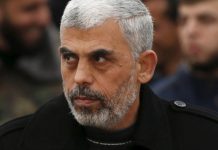
SEOUL – North Korea today fired a long-range missile into the sea, a day after Pyongyang threatened military action against South Korea and the United States over the allies’ joint military drills.
Japanese officials suggested that the missile could have been one of North Korea’s powerful intercontinental ballistic missiles with the capability of reaching the U.S. mainland, given that it flew for more than an hour before it landed in waters inside Japan’s exclusive economic zone.
The U.S. condemned the launch, saying through a National Security Council statement that while it did not “pose an immediate threat” to U.S. territory or allies, it “needlessly raises tensions and risks destabilizing the security situation in the region.”
North Korea launched the missile around 5:22 p.m. local time from the Sunan area of its capital Pyongyang, where the country’s main international airport is located, according to the South Korean military. It flew 900 kilometers (560 miles) for 66 minutes, and reached an altitude of 5,700 kilometers, before falling about 200 kilometers west of Oshima Island in Hokkaido, in northern Japan, according to the Japanese Ministry of Defense. North Korea’s state news agency, KCNA, announced the launch later, saying the missile flew 614 miles to an altitude of 3584 miles.
Based on the flight data, Saturday’s missile appears to have a potential capacity to fly as far as 15,000 kilometers (9,320 miles), said Japanese Defense Minister Yasukazu Hamada. Depending on the weight of the warhead, the mainland U.S. could have been within the missile’s range, he added.
Saturday’s missile from North Korea was launched at a high angle, according to South Korean military officials. North Korea typically fires long-range missiles almost straight up so as not to fly over the airspaces of neighboring countries.
Pyongyang’s Foreign Ministry had on Friday threatened “unprecedented” counteractions shortly after South Korea and the United States announced plans to hold nuclear drills designed to deter threats from North Korea.
Defense officials from Seoul and Washington will gather at the Pentagon on Wednesday for a tabletop exercise focusing on specific scenarios of nuclear attacks from North Korea. The two countries are also planning field exercises next month that will be upscaled from those of previous years, Seoul’s defense ministry said.
The allies say the drills are defensive in nature, but North Korea views them as “rehearsals for invasion” and typically reacts angrily.
“In case the U.S. and South Korea carry into practice their already announced plan for military drills . . . they will face unprecedentedly persistent and strong counteractions,” the North Korean Foreign Ministry said Friday via state media.
Saturday’s event also follows a record year for weapons tests by North Korea, including the launch of its largest ICBMs, named Hwasong-17.
North Korea displayed about a dozen Hwasong-17 missiles at a glitzy military parade in Pyongyang last week. Analysts said some of the ICBMs appeared to be solid-propellant missiles that can be launched more quickly and are harder to detect. The parade also showcased what state media called “tactical nuclear units.”
South Korea’s presidential today convened an emergency meeting of the National Security Council over the missile launch. “It is a serious provocation that raises tensions on the Korean Peninsula and the region,” said the council members in a statement.
South Korean President Yoon Suk Yeol, who took office last year, pledged to work more closely with the United States to strengthen the bilateral military alliance in the face of growing North Korean threats.
(c) 2023, The Washington Post · Min Joo Kim












Joe Biden is very weak and the North Koreans know that.
The North Koreans are smarter than you. Unlike you, they are very well aware who the US President is.
to bring on the scare event.